KENNEDY SPACE CENTER, Florida—Just four days after Hurricane Milton barreled through Cape Canaveral, Fla., a mission set to explore the workings of another water world blasted off from NASA’s Kennedy Space Center. Loosed from our world’s gravitational harbor by SpaceX’s fire-breathing Falcon Heavy rocket, NASA’s Europa Clipper spacecraft is now sailing toward the Jupiter system.
Its target: Europa, an ice-encrusted moon that may offer the best odds humanity will ever get for finding life beyond Earth. Europa’s interior may be home to a moon-spanning, briny sea that could possess all the elements needed to craft and cradle life as we know it: energy, chemical elements and water. And Europa’s hidden ocean is thought to hold more water than all of Earth’s oceans combined.
For decades, this moon has charmed alien-hunting space scientists. But sending spacecraft to scout extraterrestrial seas is neither trivial nor for the impatient. Voyages to the outer solar system can take so long to realize that many scientists who embark on these projects know they may not be around to see the mission’s end.
On supporting science journalism
If you’re enjoying this article, consider supporting our award-winning journalism by subscribing. By purchasing a subscription you are helping to ensure the future of impactful stories about the discoveries and ideas shaping our world today.
Today’s launch came after more than 20 years of painstaking preparations. But it’s just the first step in the latter half of the spacecraft’s $5.2-billion story. Clipper’s 1.8-billion-mile journey to the outer solar system will take around six years. Once it pulls into port at Jupiter in 2030, the spacecraft will loop around the giant, storm-wracked planet, charting a course that will carry it by Europa 49 times over four years.
“I often talk about these missions as modern cathedrals—they are generational quests,” said Laurie Leshin, director of NASA’s Jet Propulsion Laboratory (JPL), which led the construction of Europa Clipper, during a prelaunch briefing. “I’m really proud that as humanity, we choose to undertake these difficult and long-term goals, things like exploring the unknown out at Jupiter.”
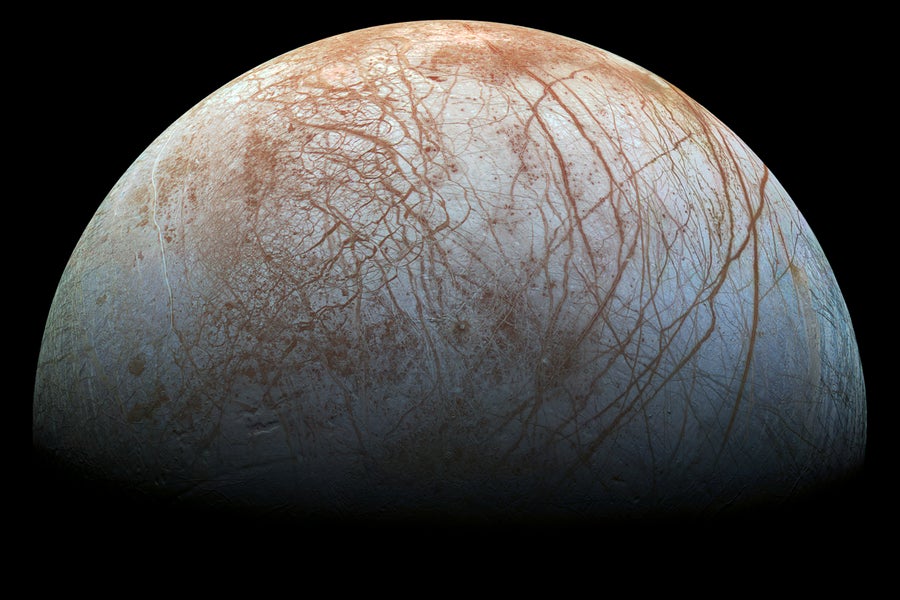
Long, sinuous fissures and ridges crisscross Europa in this color composite view from NASA’s Galileo probe, hinting at deeper geological activity that has cracked and jumbled the icy moon’s surface.
NASA/JPL-Caltech/SETI Institute
Lit only by faint shards of sunbeams, Jupiter and the rest of the outer solar system’s worlds are realms of mystery. But the Clipper mission signifies a dawning era of enlightenment as this region’s subsurface seas snap into sharper focus. Scientists are now turning their gaze not only to Europa, but to other ocean-bearing icy moons such as Saturn’s Titan and Enceladus—each of which could be habitable (and inhabited) today.
“It’s a movement toward exploration of a whole new class of objects, ocean worlds, that we didn’t realize were a thing a couple of decades ago,” says JPL’s Robert Pappalardo, Europa Clipper’s project scientist. “And we’re going to be exploring, in-depth, what this type of world is like, a type of world that might be the most common habitat for life that exists, not just in our solar system but in the galaxy.”
If our solar system is any guide, such small, icy satellites greatly outnumber planets, and they could transform our ideas about where life might thrive. Clipper’s goal is to take the first steps toward knowing whether Europa really is a habitable world—to confirm that, as most every space scientist is already convinced, an ocean is truly tucked away beneath the moon’s crust, where it perhaps has brewed biology’s raw ingredients for billions of years. The mission’s personnel suspect they’ll find a life-friendly deep, but until the spacecraft arrives and does the work, no one knows for sure.
With its nine onboard instruments, Clipper will also study Europa’s otherworldly chemistry, make detailed maps of the moon’s icy, chaotic surface, search for enigmatic plumes of water vapor wafting into space and use ice-penetrating radar to look for lakes within the frozen rind. That is, if its hardened electronics—shown in a late-breaking curveball to be more vulnerable than expected to Jupiter’s spacecraft-frying radiation—can survive the onslaught that awaits.
“Missions like Clipper are building on what has come before,” says Elizabeth Turtle of the Johns Hopkins Applied Physics Laboratory (APL), who leads one of the spacecraft’s camera teams. Turtle is also leading the Dragonfly mission to explore Titan, slated to launch in 2028 at the earliest. “We are incredibly lucky to have this diverse array of worlds in the outer solar system, to be able to give us so much information about the different types of evolution that can happen for these kinds of planetary bodies with an ocean.”
Extraterrestrial Seashores
In 1609 Europa was but a twinkle in Galileo Galilei’s eye when he aimed a homemade telescope at Jupiter and spotted several smaller dots of light. After plotting their motions, Galileo correctly surmised that the quartet were not distant background stars but Jupiter’s most noteworthy lunar companions.
Now, four centuries later, Europa, Io, Ganymede and Callisto—known as the Galilean moons—are challenging stale conceptions about where clement, life-friendly conditions can exist. For a time, scientists thought habitability mostly depended on a world’s distance from the radiant warmth of its star; they also assumed the outer solar system was a frigid domain that for eons had been bereft of much geological activity.
“It wasn’t really conceivable for our first trips to the outer solar system to even think about including the search for habitable environments,” says Curt Niebur, Clipper’s program scientist at NASA headquarters. “It just wasn’t in our worldview.”
But in 1979 NASA’s twin Voyager spacecraft swept by Jupiter and revealed “strange new ‘worlds’ of fire and ice”—ongoing volcanic eruptions on Io, terrains on Ganymede that turned out to vary in age by billions of years, a curiously youthful icy crust on Europa—and strange clues that, perhaps, something sloshed beneath.
Then, in 1995, NASA’s Galileo spacecraft slipped into orbit around Jupiter to scrutinize the planet and its moons. The probe found that, warmed by gravitational interactions between Jupiter and one another, the Galilean satellites teemed with geological activity. Io was the most volcanic object circling the sun; Europa’s sprightly terrain suggested something akin to plate tectonics had resurfaced the moon’s frozen face and shuffled material from the surface to the depths. And the fuzzy hint of a watery interior? That sharpened into almost indisputable evidence for a buried, global, saltwater sea—albeit one of unknown depth—held within a frosty shell of unknown thickness.
Now, based on those observations and studies of Saturn’s oceanic moons, it seems that a world’s biological potential does not depend solely on the distance from its sun—and maybe not even on sunlight at all, if the lessons we’re learning about life in Earth’s darkest nooks are applicable to alien worlds as well.
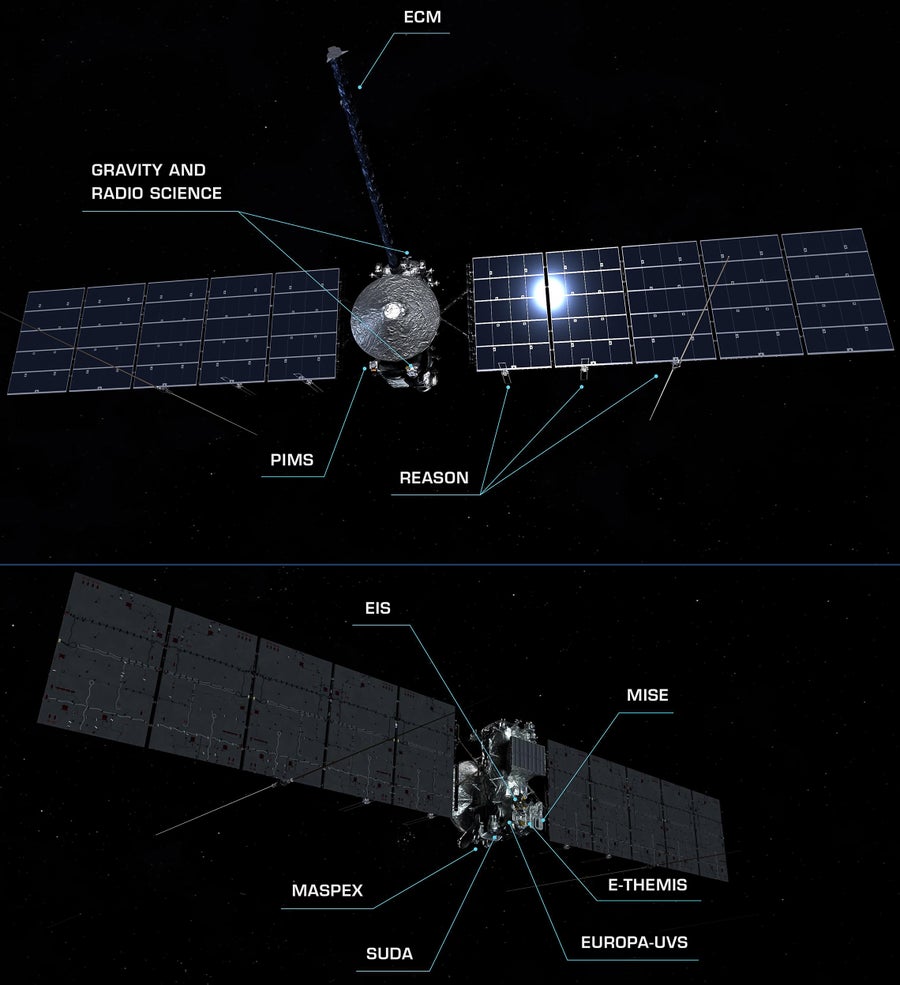
This paired front-and-back view highlights Europa Clipper’s nine science instruments—as well as the spacecraft’s enormous solar panels, supersized to gather the faint sunlight in Jupiter’s vicinity.
“It hasn’t been long that we’ve known there are oceans out there, and so I think it did take a while to fully appreciate the implications,” Turtle says. “And now, one of the key areas of scientific interest is habitability—from an astrobiological perspective, how large is the habitable zone around stars?”
Building on years of advocacy from planetary scientists, in 2011 a high-level expert committee that defines NASA’s science priorities recommended focusing on a large-scale mission to study Europa and its ocean, labeling the moon as “one of the most important targets in all of planetary science.” Until then, the bulk of NASA’s astrobiology funding had focused on Mars—a world that is almost certainly sterile today (at least on the surface), but which may have hosted life some 3 to 4 billion years ago in its warmer, wetter past. Finding space for other worlds within the relentless drumbeat for Mars, a planet right next door, had proven challenging. But the 2011 directive infused momentum into a project that had been quietly coalescing for years: a dedicated Jupiter-Europa mission, conceived by Pappalardo and others.
With the help of planetary science advocacy groups and former Congressman John Culberson—himself a Europa afficionado, well-versed in the scientific literature and passionate about finding alien life—the mission that eventually became Europa Clipper got the green light from NASA in 2015, and the team began designing the spacecraft, plotting its trajectory and building the instruments.
The final product that launched today isn’t much like early concepts. But Europa Clipper is the largest spacecraft yet built for interplanetary exploration: a 7,145-pound probe that, with its giant solar panels unfurled, has a wingspan exceeding 100 feet. It carries world-class cameras, a magnetometer, a surface dust analyzer and the most capable mass spectrometer—which ingests molecules to determine their composition and origin—ever flown.
“The one thing that we never doubted was that this was going to be worth it,” Niebur says. “This is an epic mission. It’s a chance for us to explore not a world that might have been habitable billions of years ago, but a world that might be habitable today, right now.”
It’s also a mission that, despite many fateful escapes from near-death experiences during its long incubation, almost succumbed to a potentially fatal last-minute plot twist.
A Lethal Challenge
In 1959, two years before he came up with his eponymous framework for estimating the prevalence of life in the cosmos, astronomer Frank Drake aimed a radio telescope at Jupiter and detected the unmistakable signature of high-speed electrons tracing twisted pathways along magnetic field lines. Called synchrotron radiation, the signature exists because Jupiter’s magnetic field is strong enough to accelerate charged particles to near light speed. The implication of Drake’s observation was undeniable: massive, intense radiation belts swaddled the planet, effectively forming a kill zone for unshielded spacecraft.
“Jupiter’s magnetic field is 20,000 times more powerful than Earth’s. It’s basically a giant particle accelerator,” says Jordan Evans of JPL, Clipper’s project manager.
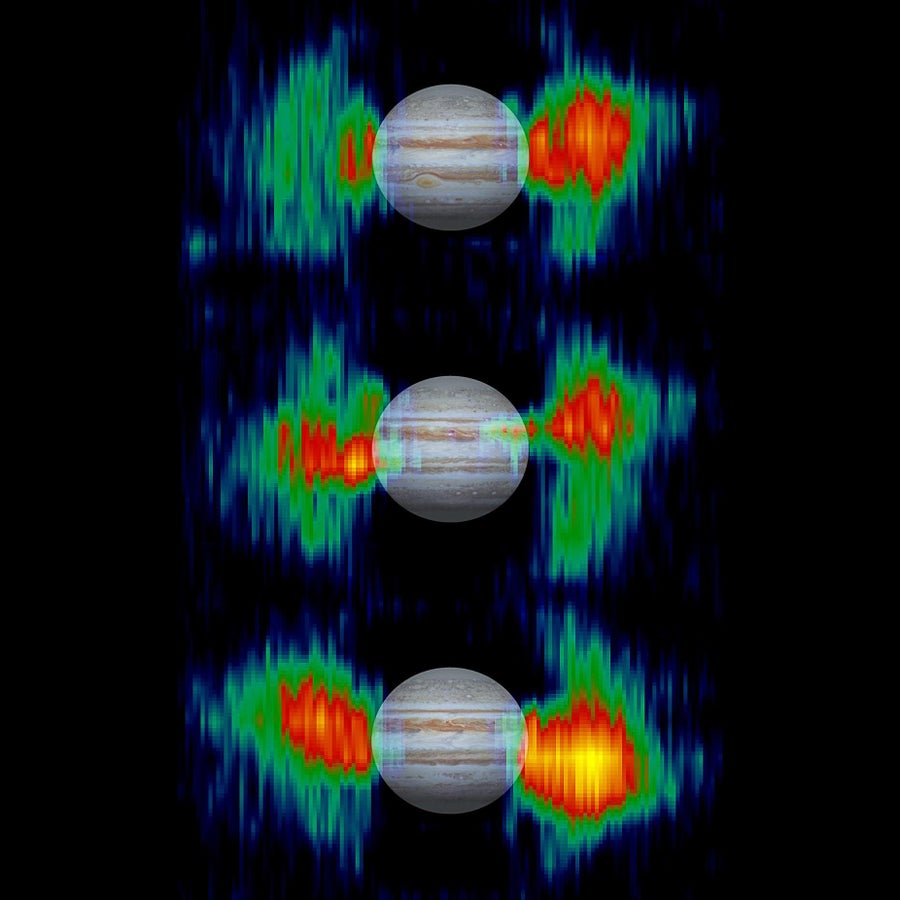
Three views of Jupiter’s sprawling and deadly inner radiation belts, based on data from NASA’s Cassini spacecraft. Each view comes from a different point in the giant planet’s 10-hour rotation, revealing how the seething, spacecraft-frying emissions change over time.
Every spacecraft destined to explore the Jupiter system is specially designed to endure (at least for a time) those lethal belts. Europa Clipper was no different, as its lunar destination boasts an intense radiation environment. But at a meeting in May, shortly before Clipper was scheduled to ship to Florida, NASA engineers learned that some of the radiation-hardened circuits aboard the spacecraft were unexpectedly vulnerable. The information came from another government agency that had purchased the same parts from the same German supplier. Called metal-oxide-semiconductor field-effect transistors, or MOSFETs, the weakened parts are transistors that basically act as toggle switches. And this batch of MOSFETs degraded under lower radiation doses than promised—doses so low, in fact, that it was questionable whether Clipper could survive long enough to deliver the observations the team had dreamed of for decades.
“I was devastated,” Evans says, recalling that day in May. “It was hard to imagine a path forward. But then you take a step back, and you start to methodically think through things.”
Within a day of learning about the problem, a team got to work on it. Soon, they had identified more than 1,000 faulty MOSFETs aboard Clipper. The transistors were distributed across the spacecraft and integrated into each instrument system; they were also in the now-sealed electronics vault, a specially shielded compartment that is like the nerve center of the entire operation. The mission was in peril. There was no time to delay: if the spacecraft stayed in California at JPL for the team to replace the faulty parts, it would miss its launch window and might never leave Earth.
“I was having nightmares every night. I really was,” Pappalardo says. “It was like our spacecraft was sick, and we didn’t know if we would make it. It was awful.”
Betting on success, JPL sent Clipper to Kennedy Space Center anyway. And over the summer, worried scientists and engineers worked days, nights and weekends to devise a solution to a vexing problem they hadn’t even created. By the end of August, they had a fix.
Rather than replacing each faulty part or modifying the observation plans, the spacecraft would fly as is. It would follow its planned sequence of 21-day orbits around Jupiter, circling the giant planet 80 times. At most, it would spend one day during each orbit within the radiation belts. For the rest of the time, when Clipper was outside the harshest radiation, the team could turn on some of the spacecraft’s heaters, warming the weakened circuits in hopes of repairing some of the radiation damage through a process called annealing—essentially a thermally induced salve that redistributes charged particles within a circuit to preserve the switch’s integrity.
It seemed like a miracle solution, almost too good to be true given its forecasted minimal impacts on Clipper’s science.
“I started off devastated…, and then by the time all was said and done,” Evans says, “I was humbled. I was humbled by what the team was able to accomplish.”
Understanding an Ocean World
As Clipper swoops by Europa, its nine science instruments will be trained on the moon, seeking to understand how it all works. They’ll make detailed maps of the surface. They’ll gauge the ice shell’s thickness and whether it contains lenses of seawater, much like Earth’s Antarctic ice cap. They’ll remotely study the ocean beneath, which could be in contact with a rocky, mineral-rich seafloor. And they’ll study the composition of the moon’s surface, which could reveal more about the concealed ocean and the chemistry that could power alien ecosystems.
“If we go there and we find water and energy and chemistry, that opens up a whole realm of questions,” Nicola Fox, NASA’s chief of science, said during a prelaunch briefing. “If we go there and we find no water, no energy and no chemistry, that also opens up a whole wealth of questions—why did we think this? And why is it not there?”
In other words, if the clarion call of Europa is nothing but a siren song, how could scientists have been led so horribly astray? (No one expects that will be the case, although as all good, cautious scientists do, they’ll wait to see the evidence.)
“So we’re going to see, is Europa really—as we think—a habitable world,” Pappalardo says.
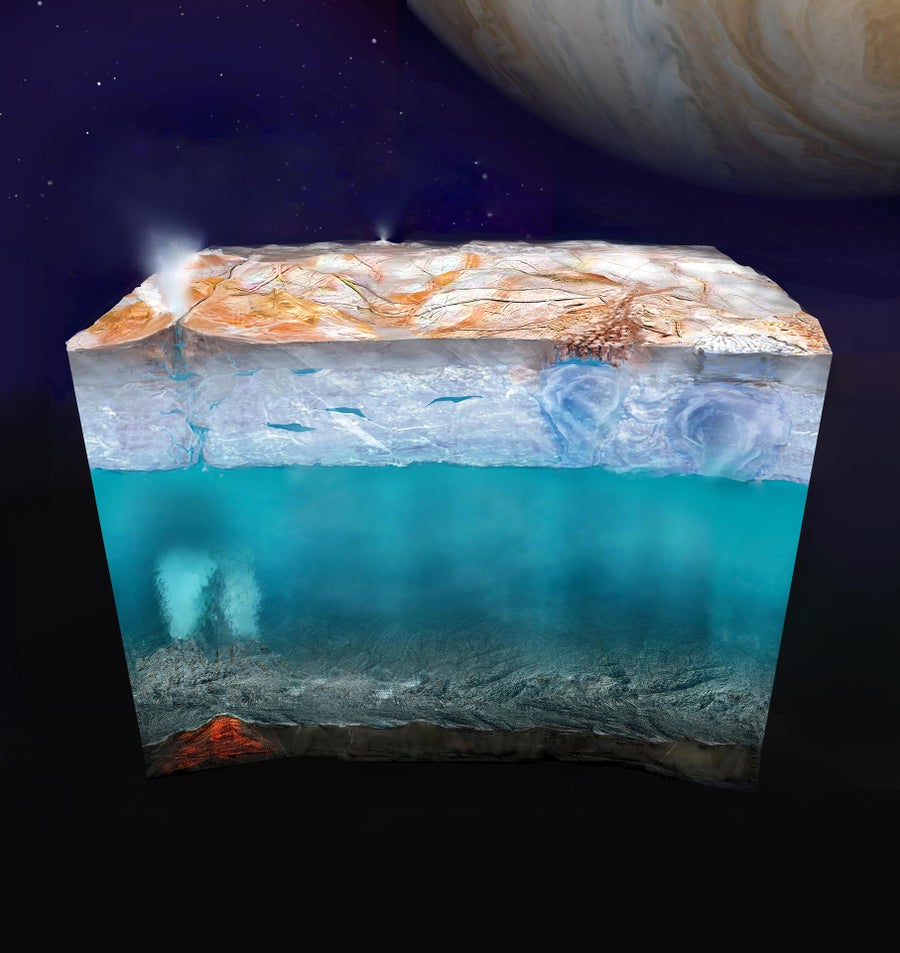
What lies beneath Europa’s frosty exterior? This not-to-scale artist’s concept shows one possibility: a deep, global saltwater ocean, surmounted by a sizable crust of ice and with an underlying rocky core. Energy and nutrients may well up from below via hydrothermal vents on the seafloor or could trickle down from above via convective processes within the crust. Plumes of material may vent from the surface into space, sourced either directly from the ocean or from liquid-water reservoirs trapped within the crust.
As the spacecraft flies, it will also look for any signs of Europa’s enigmatic, are-they-or-aren’t-they-there plumes—tentative puffs of water vapor first described in 2013 that would be smaller, more subtler versions of the energetic geysers erupting from Saturn’s moon Enceladus. According to the mission’s lore, those plumes are part of the glue that sealed the deal on Clipper; if the spacecraft got lucky, it could fly through a plume and directly sample the stuff of Europa. And while NASA is not billing Clipper as a life-detection mission, flying through a plume could prove otherwise—although this occurrence hinges on several unlikely events.
“There are a lot of ifs, right?” Pappalardo says. “If there are plumes, if plumes are connected to an ocean, if that ocean is rich enough in life—and therefore the mass spectrometer could get enough of a sample, then it could look at the pattern of organics and we could try to infer whether that signature might point to biotic processes. It’s not impossible, but it’s a very low probability event.”
Messages in a Bottle
Clipper will, if nothing else, provide some ground truthing for the idea that when it comes to the rules of life, a world’s distance from its star is far from the only thing that matters. And understanding the fundamentals of habitability is crucial for filling in the values of the Drake equation—a framework, devised by the same astronomer who inferred the presence of Jupiter’s radiation belts, that has guided the search for life beyond Earth since the early 1960s.
These questions, Pappalardo says, “really bring me back to [Drake’s] class”—his undergraduate astronomy course at Cornell University that Pappalardo took in the spring of 1984—and “all these things that we were on the doorstep of being able to know.”
“I think about how far we’ve come in the direction that he was pointing. And it wasn’t a finely tuned direction, it was a broad direction to go out and explore and search,” he says. “And we’re doing it. It just takes time.”
In the grandest sense, Drake’s fingerprints are all over Clipper’s mission. Even after his retirement, he continued to relish the chance to observe Jupiter and its moons into his 90s, often gazing at the planet as it rose above the beloved redwood trees that ringed his home in the hills outside Santa Cruz, Calif. But Drake (better known to me as Dad) didn’t live to see Europa Clipper launch. In the 60 years since Dad wrote the formula we now use to confront our apparent cosmic solitude, the field of astrobiology has emerged and matured. Clipper’s lead scientists, many of whom started their careers in the 1970s or 1980s as graduate students or postdocs on Voyager or Galileo, are now at the helm. And the next generation of leading planetary scientists, most of whom weren’t even born when we lobbed our first probes toward the outer solar system, are now working on Clipper.
“It’s always been part of the arc, if you will,” Turtle says. “One of the things on Europa Clipper and on Dragonfly”—NASA’s upcoming mission to Titan—“that we take very seriously is this opportunity and responsibility to bridge the generations.”
Time, it seems, is the resource that exploring the outer solar system most requires. Every Clipper team member knows this mission could be their fleeting, once-in-a-lifetime chance to get a close look at Europa. Because when it comes to the outer solar system, as a scientist, “it really is an acceptance that you are a piece of something greater than yourself,” Niebur says. “You have to be willing to contribute and commit to something that is bigger than you, something that is going to go on longer than you.” And so, the Clipper team decided to commemorate this first voyage from one ocean world to another.
Sealing the spacecraft’s vault—its nerve center—is a plate forged from tantalum metal. On the front of it, facing the stars, is a visual representation of “water” spoken in 103 languages. On the inside, facing the spacecraft’s beating heart, are more personal reflections. One is a poem by Ada Limón that describes the watery ties binding humanity, Europa and Earth. Another, a portrait of Ron Greeley, a planetary scientist whose leadership helped to make Clipper what it is.
And at the very top of the plate is the Drake equation, rendered in Dad’s handwriting.
Unlike other messages we’ve sent into the stars, Clipper’s tidings will go only as far as the Jupiter system. When the spacecraft bearing our dreams and inscriptions ends its mission on Ganymede, where any hitchhiking Earthly microbes are unlikely to contaminate the moon’s lifeless surface, the vault plate and its records of humanity will end with it—in a kind of bittersweet finale that will keep Europa, with its promise of extraterrestrial life, safe for future generations to explore.


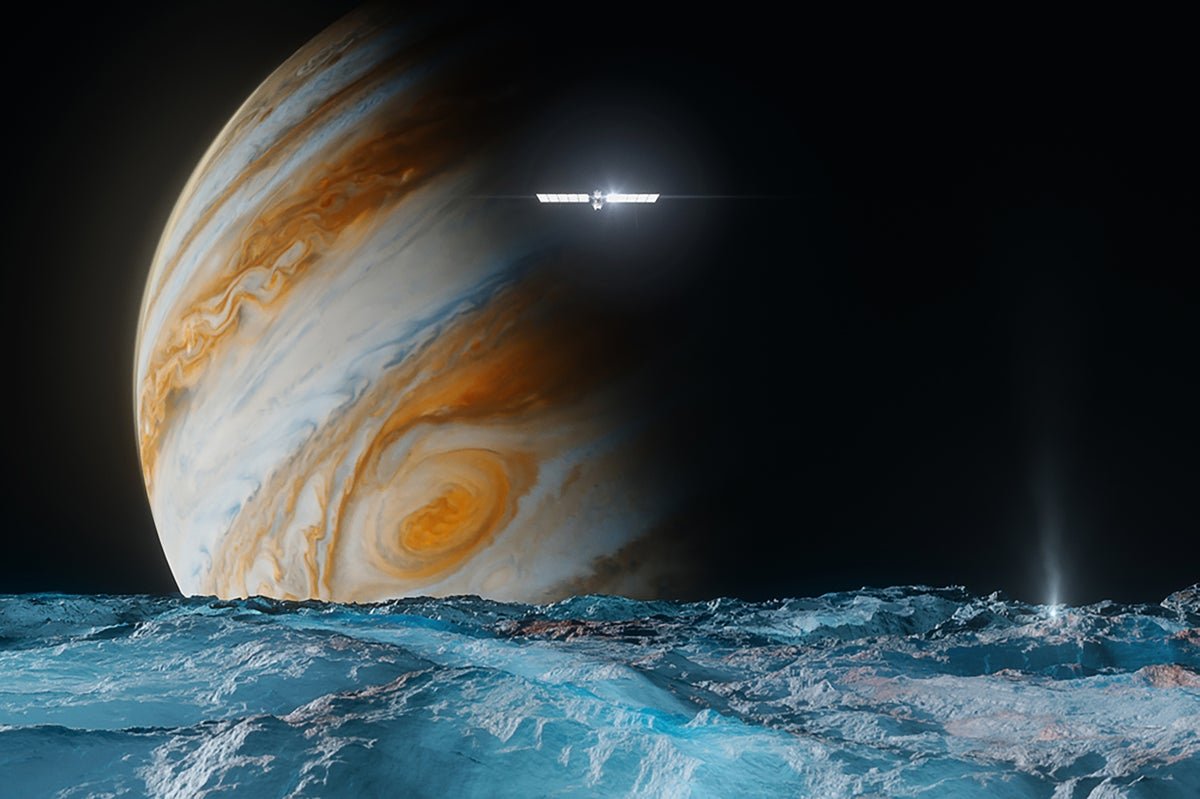










Leave a Reply